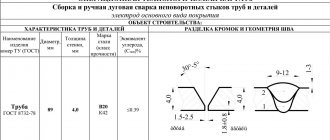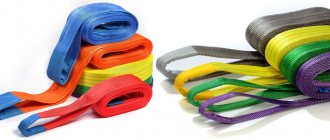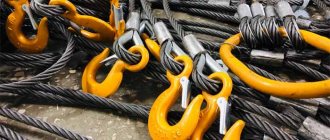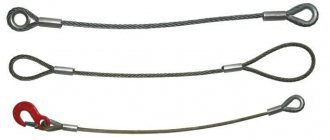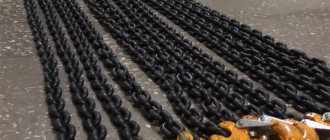2T STP Sling
Synthetic slings are made from textile fibers, but are strong enough to lift heavy weights and protect expensive and fragile loads from scratches and denting.
Are you tired of bulky lifting slings that are heavy and difficult to maneuver when hooking and lifting loads? Are you concerned that a chain or rope will damage, scratch or crush your delicate cargo? – A synthetic sling may be the best choice for your lifting equipment as it can provide the flexibility, secure slinging and reliable support needed to move any item around the job site or load it onto a vehicle.
Textile slings come in two main types: flat (belt)
and
round (round-stranded)
. They can be made from a variety of materials, but they are most often made of nylon or polyester. The two materials are very similar in appearance and it is difficult for anyone but the most experienced person to tell them apart visually. This is one reason why you should always check the markings on the sling before use.
Synthetic fiber rigging slings have the following general properties:
- Durability
- depending on the size, synthetic fabric slings can withstand loads of up to 100 tons. - Convenient and safe
- the flexible strap adapts to the contour of the load and holds it with a tight, non-slip grip. - Protects Loads from Damage
- Unlike other sling materials, the webbing's soft texture is less likely to damage, mar, or scratch polished surfaces. - Shock Absorbing Capacity
– Minimizes shock loads and shocks. - Heat resistance
- the load-bearing capacity of the synthetic material is not affected by temperatures up to 82 degrees Celsius. - Cost-effective
– slings made of synthetic fabric have a low initial cost and a long service life. They are unaffected by mold, rot or bacteria, are resistant to some chemical attacks and have excellent abrasion resistance.
Synthetic slings are extremely versatile and can be used in vertical, ring and basket hitches. They are easy to transport and set up with just one person, making them an excellent choice for general lifting applications.
Selecting a sling by material
The first step to choosing lifting equipment is to determine the belt material suitable for specific operating conditions and the nature of the work. There are several options to choose from: nylon (polyamide), polyester (polyester), polypropylene. By studying their properties, you can understand which one is best suited for your application.
When choosing a material for a synthetic sling, it is recommended to consider resistance to certain chemicals, heat resistance and stretch.
Below we'll look at some of the features and characteristics of polyester and nylon slings to help you make a more informed decision.
Features of polyester slings
- Approximately 3% elongation at rated load capacity - low shock absorption allows for better load control during lifting.
- Polyester is a softer material and less abrasive to sensitive or delicate surfaces.
- Lower moisture absorption compared to nylon, quick drying.
- Polyester slings can be used in explosive environments (for example, in the mining industry), the material is non-sparking and non-conductive.
- Resistant to acidic environments and interaction with bleaches, oils and fats.
- Polyester is available at a relatively lower cost than nylon.
- Not recommended for alkaline media, including aldehydes, ethers and strong alkalis.
- Cannot be used at temperatures above +90°C or below -40°C.
Features of nylon slings
- 8-10% elongation at rated load capacity - this reduces impact loads, but high elongation must be taken into account for low ceiling height lifts.
- Resistant to grease and oil.
- Resistant to aldehydes, ethers and strong alkalis.
- Nylon slings are not recommended for acidic environments or for use with bleach.
- High moisture absorption, which can increase elongation under load.
- Conducts electricity due to its ability to retain moisture.
- Cannot be used at temperatures above +90°C or below -40°C.
Conclusions:
Polyamide (nylon) slings are more elastic, they better resist the transfer of shock loads to the crane. However, they lose more than 15% of their load-carrying capacity when wet and should not be used near acids or bleaches.
Polyester slings are softer and adhere better to the surface of the load. They have low elongation and therefore transfer slightly more instantaneous load to the crane when an impact load occurs. They cannot be used near ethers and alkalis, but are resistant to acids.
Both nylon and polyester slings are suitable for easily damaged loads, but if you are wondering which one is better to use for the most delicate loads, it is polyester. Chemical coating of nylon tape gives it a rougher texture.
If the sling is used in a chemically active environment, be sure to choose a material that will not be harmed. Chemicals may be found in the air or on any surface that the device may come into contact with. It would be unwise to lift lead-acid battery trays with nylon slings or lift alkali tanks for industrial cleaning with polyester slings. Any synthetic material can be damaged by certain chemicals. Before using slings in chemically active environments, their resistance to aggressive substances should always be taken into account. When working with hot materials or in very hot or cold conditions, nylon or polyester slings may not be the best choice.
What are textile slings made of?
The main material used in the production of textile slings is elastic fabric tapes that are insensitive to temperature changes and resistant to tearing influences. The belts may contain three types of textile fibers - polyamide (PA), polyester (PES) and polypropylene (PP), which have the following mechanical requirements:
- heat resistance. General purpose textile slings are used for lifting loads whose surface temperature can range from -40C to +10C. If the specified temperatures are possibly exceeded, the material should melt and not burn;
- moisture resistance. It is determined by the so-called moisture absorption coefficient, which should not exceed 3-4%;
- resistance to aggressive chemical compounds;
- deformation of the material during transportation should not exceed 10-15%;
- slings should not absorb oils, greases, grease and petroleum products.
More on the topic: Requirements for cargo rope slings for construction according to GOST 25573-82
Identification marking
So how can you make sure you're using the right sling for the job? Each product has a tag or other identifying marking that identifies, at a minimum, the synthetic material and load rating, as well as the manufacturer's name, trademark, or logo. Moreover, the color of the tag corresponds to a specific material:
- BLUE: polyester (PES)
- GREEN: polyamide (PA)
- BROWN: polypropylene (PP)
If any part of the tag is missing or illegible, the equipment is not fit for use and must be taken out of service.
Determining the load capacity of textile slings by color
The color coding system is part of numerous regulations in the field of lifting work using textile lifting devices. The regulations require that different color codes be used to visually identify the safe working load limit of textile slings.
| Color | Maximum load, t |
| Violet | 1 |
| Green | 2 |
| Yellow | 3 |
| Grey | 4 |
| Red | 5 |
| Brown | 6 |
| Blue | 8 |
| Orange | more than 10 |
Textile sling options
Requirements for the design, materials and safety of general-purpose cargo slings made of textile tape are defined in the RD and TU documents, which were developed by specialists from manufacturing companies.
Explanation of some designations of textile slings:
- STK
– ring - STP
– single loop with soft loops - 1ST
,
2ST
,
3ST
,
4ST
– one-, two-, three- and four-legged with hooks and ring
The letter “K” is added to circular products:
- STKK
– circular circular strand - STPK
– single loop round strand
Types of slings and designation
The most popular and universal are ring (STK) and loop (STP) slings. The ring configuration is designed for tying loads (not hooking) and allows the user to rotate the hook and load contact points, which increases the durability of the straps.
Loops are often called "rag chucks" and have the ends (loops) wrapped with extra material to prevent rapid wear and tear at the contact points.
Load-handling devices 1ST, 2ST, 3ST, 4ST allow you to organize the lifting of cargo using one, two, three or four lifting gripping points. Their branches are united by an upper power ring for hanging on a crane hook and can have various designs of metal end elements (hooks, rings, brackets).
Ring sling STK
Types and classification
A textile sling consists of two loops and a tape - a free piece of material between the loops. The length of the tapes determines the technological capabilities of slinging the load. Two types of textile slings have found practical application - loop and ring. Technologically, they differ in different ways of connecting the loop part to the tape part.
Loop slings (designated STP) can be manufactured in three ways:
- By stitching the tape through with its wrong side without preliminary twisting.
- Forming a loop by twisting the end ribbon part into a Möbius ring, as a result of which the width of the loop decreases and its rigidity increases.
- By folding the tape part in half, which accordingly increases the strength of the loop, but is accompanied by increased material consumption.
Since the hinges bear the entire load and are also in direct contact with the crane hook, a double hinge will have the greatest durability, and a flat hinge will have the least durability.
Textile ring slings (designated STK) have an oval cross-section and are characterized by increased rigidity. However, their adherence to the surface of the load is worse than that of tape slings. Such slings are used to secure long loads. Their price exceeds the price of tape slings by 10...20%. For softer coverage, ring slings are produced as round strands and are marked with the designation STKK.
Textile slings are often equipped with oval steel rings, which, using connecting brackets, hang the slings on the crane hook. The use of such rings reduces wear on the loop. For the manufacture of rings, construction medium-carbon steel grades 30GS or 40G2 are used, which are hardened. Depending on the number of such rings, single- and multi-branch slings are distinguished. The load-carrying capacity of the latter, with the same width, thickness and method of connecting the ends, is always higher. In addition, multi-branch textile slings more evenly distribute the load over the contact surface of the hook, and contribute to a more reliable fixation of the ring in the throat of the hook.
Textile slings are classified not only according to their design, but also according to their permissible load capacity. In particular, single-leg textile slings are produced in a width range from 30 to 3000 mm, with a length from 0.8 to 3 m. They allow you to safely secure loads weighing from 500 kg to 20 tons. The permissible deflection height of such slings when loaded should not be less than 2 m, since in this case the angle of coverage of the load goes beyond safe limits (no more than 120º is allowed). The number of branches is indicated in the marking of the sling: for example, the designation 1STK indicates a single-branch ring textile sling, 4STP - a four-branch tape sling, etc. With an increase in the number of branches, the length of the sling decreases, which is associated with improved conditions for covering the hook with several rings simultaneously.
Textile slings are also classified by the number of layers of tape: under increased loads they can be two- or even three-layer. As a result, the permissible load can be increased by 40...50%.
An important element in the marking of textile slings is their color. It indicates the maximum load capacity of the device:
- Purple – load capacity not more than 1000 kg;
- Green - load capacity not more than 2000 kg;
- Yellow - load capacity not more than 3000 kg;
- Gray - load capacity no more than 4000 kg;
- Red - load capacity not more than 5000 kg;
- Brown - load capacity no more than 6000 kg;
- Blue - load capacity no more than 8000 kg;
- Orange - load capacity more than 10,000 kg.
Want to know everything about chain slings?
What is a round sling?
A round (round-strand) sling is a looped sling (STPK) or a closed ring (STCK) consisting of an internal load-bearing polyester core covered with a wear-resistant woven seamless sheath made of polyester or nylon yarn. Since the base consists of a bunch of polyester threads, its body is soft, elastic and very durable.
Circular sling
What are the advantages of round strand slings?
Round slings are superior to tape slings in ductility and load-carrying capacity; they are able to twist and bend in any direction, are easily wound under a load and are better able to withstand long-term dynamic loads.
The fabric outer sleeve protects the internal load-bearing fibers from mechanical damage, abrasion, dirt, oiling, as well as from ultraviolet radiation, so the service life of round-strand fibers is an order of magnitude higher than that of flat tape counterparts.
Round strand ring slings allow you to organize almost any slinging method, they are especially useful when lifting pipes, poles, logs, cylindrical objects and loads with uneven contours.
The closed ring shape allows you to change the points of contact with the load and extend the life of the device, and since the core threads do not come into direct contact with the load, there is no loss of strength due to abrasion.
Less stretch (about 3%) at rated load capacity prevents "bounce" when lifting. After removing the load, the product returns to its original length.
The sheathed round sling is an economical choice for heavy-duty lifting or hauling applications. Although it is preferable to use for heavier loads (from 6 tons), the choice depends on your personal preferences.
Advantages, difference from other types
STP is made from a piece of tape made from imported polyester material, with loops at the ends.
In addition to loops, at one end of such slings there may be steel hooks or staples. What is the advantage of such slings over others?
- Soft but durable material from which the slings are made. STP, unlike steel slings, will not crash into the load when lifting, thereby damaging it.
- Safety in moving cargo. Metal slings can damage the load with just one protruding steel thread.
- Easy to use. Maximum comfort of use – the ability to use without gloves.
- Low cost.
- Small dimensions. STP is very easy to roll up and store in this form. This is not possible with metal slings that have a spring element built into them.
- Light weight. This is especially noticeable when moving large loads. One worker can easily handle one heavy-duty sling, whereas steel slings would require the help of a whole team.
- Increased performance. FSW are not affected by chemicals or water, they do not corrode. They quickly return to their original shape.
What is the safety margin of textile slings?
The term load rating refers to the maximum working load that the sling manufacturer claims it can withstand. Tape and round strand load handlers made from high-strength synthetic fibers are manufactured with safety factors of 6:1, 7:1 and even 8:1, meaning they have a tensile strength of six/seven/eight times the rated working load limit. But this does not mean that they can be loaded beyond their rated capacity. Impact and lateral loads negatively affect their strength.
Requirements for the use of textile slings
The safety rules for loading and transport operations stipulate the use of only those types of textile slings that have passed strength and elongation tests in laboratory conditions and have an appropriate quality certificate. The use of damaged products with frayed or cut fibers, burns, or twisted or deformed in any other way is not allowed.
When the belts are worn out, it is prohibited to repair them using materials other than those used in production. The type of weaving minimizes their mechanical wear and protects the product from exposure to dampness; Also, to reduce the impact of external harmful factors, the use of special covers, protective tapes and gaskets is allowed, if it does not imply a reduction or exceeding the required stretch limit of the sling.
These auxiliary materials ensure a tight fit of the harness to the load, regardless of its dimensions and texture, and also reduce the resulting friction and increase the reliability of fixation.
How does the sling angle affect the lifting capacity?
When slings are used at an angle during lifting, their lifting capacity is reduced because additional tension is created on the branches. As the angle between the slings increases, the breaking force on each leg increases. Acceptable angles are up to 90° and no more than 120°.
For example, if the angle α is 90°, then each leg of the sling experiences a load equal to 71% of the weight of the load. And with α equal to 120°, each leg already has a force equal to the weight of the load. In any case, the slinger must take into account the angular stress of the branches and use reduction factors for the lifting capacity.
When lifting directly (vertical position of the coupling device), the coefficient is 1, which means you can use the full lifting capacity of the sling.
When slinging “with a noose”, the coefficient is 0.8, that is, the load capacity of the chuck is reduced by 20%.
With the “basket” slinging method, if the branches are located vertically at an angle of 90° to the horizontal, a factor of 2 is applied, and the lifting capacity of the sling is doubled.
What is the shelf life of synthetic slings?
Weather conditions, environment, intensity of use - all play an active role in determining the service life of slings. During use, never exceed the rated working load limit and avoid shock loads. On average, the shelf life of a textile tape sling is 3 months, subject to intensive use in one work shift.
You should always minimize sling movement on any surface during lifting, dragging on the ground, and never pull the sling out from under the load. Avoid heat exposure and weld spatter, as well as the use of hooks, shackles and other hardware with burrs or rough edges. Do not allow vehicles to hit the seat belts.
We would be remiss if we did not take into account the possible abrasion of synthetic slings. They can become abrasively damaged or even melt at room temperature due to the friction caused by moving across a surface under load. Always consider the effects of abrasion and the different ways to protect the sling during use. For example, you may want to wear corner protectors or sleeves where wear is expected, especially where the load has sharp edges.
Storage conditions also affect the overall integrity and strength of the tooling, which encourages consumers to ensure optimal storage conditions - a cool, dry place, protected from UV exposure, away from chemicals and heat sources.
Design features:
The material for this type of sling is durable synthetic fabric (polyester, polyester, polyamide, lavsan, terylene), which can withstand quite a lot of weight. When transporting, they can be compactly rolled into a small roll. Depending on the type of sling, the number of layers of textile tape can be from 1 to 4. The color indicates the approximate load capacity for this device, in some cases it reaches 100 tons. During operation, these slings stretch, but after removing the load they return to their original shape. Sometimes they are used in conjunction with protective pads (covers) to prevent damage from sharp edges of the load.
Textile slings must comply with RD 24-SZK-01-01. Each product has a tag indicating the load capacity, length, name or trademark of the manufacturer, date of manufacture, serial number. If this data is unreadable or the tag is missing, then the sling is not allowed to work. To avoid damage to textile slings, metal tags are not used on them. Typically polypropylene or leather is used. Marking is allowed on the sling itself in a place where it will remain until the end of its service life.

